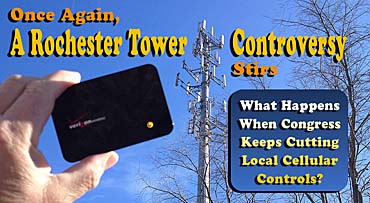Serving the Towns of Wawarsing, Crawford, Mamakating, Rochester and Shawangunk, and everything in between | |||
| |||
|
Once Again, A Rochester Tower Controversy Stirs
What Happens When Congress Keeps Cutting Local Cellular Controls?
KERHONKSON – The cell tower on City Hall Road in the Town of Rochester is once again the center of a dispute in the town.
The tower was erected in 1997 on land belonging to Cliff Wicks despite angry opposition from town residents. The town passed a moratorium on such towers, but lost its case in court... an inevitability, many have since said, considering the wording of the 1996 Telecommunications Act which specifically removed local municipalities' ability to prevent cell towers being erected. The argument then was simple: if America was to have a good quality cell phone system then thousands of towers would be needed, and localities everywhere would try to block them. Congress therefore limited local authorities' control over cell towers to questions of height, color, flashing lights and aesthetic concerns. The City Hall Road tower was cut down from 180 feet to 120. As is now very well understood, the cell phone has become the dominant technological motif of our day and the thirst for data and bandwidth has driven the industry to provide the equivalent of 1985-era supercomputers in our pockets, and ever higher efficiencies in antennas on their towers. Which has also meant more towers. The Town of Rochester added two more in 2006-7, both on town-owned property. This provided full coverage in Rochester except for pockets in its extreme southeast and northwest areas. However, due to folds in the landscape, there are still weak spots in the rest of the coverage area. Meanwhile, there has also been a wave of consolidation within the tower industry. The providers of cell service — Verizon, Sprint and AT&T — do not usually build or own towers; moreover, they nearly always "co-locate" on the towers that exist, with each provider holding a tier of antennas. The sponsoring company will take the top tier, and the others will negotiate for the second, third, fourth etc. Last year, American Tower, the industry leader, was in negotiation to buy Global Tower, which owned the tower on City Hall Road. At that time, it now appears, Global Tower decided to conduct some upgrades of what it had and had a company called Peg Bandwidth brought in to put on some antenna dishes. Peg Bandwidth is a well-known firm that deals with the "backhaul requirements" for cell networks. Backhaul is the part of the network that intersects with the internet, meaning that data is beamed off the local tower to another, more central location, and from there the internet connection is made. This is crucial to cell phone companies' business today, which is moving from a 3G to a 4G platform, with ever increasing data flows, bandwidth and internet connectivity. American Tower purchased Global Tower for $3.3 billion last December. The deal brought American Tower 5,400 more towers, and management rights to another 9,000 sites. At the local level, residents noticed that there was work being done on the tower without any notice given, nor any planning permission. "Global subcontracted the work; the tower needed to be reinforced to hold new antennas. So they put in three guy wires which meant, of course, that they dug out the ground and put in concrete blocks and wires up to the pole... The new antennas are for 4G," said Jason Broome, who has been active in opposing work on the tower, and now sits on Rochester's telecommunications committee. "This meant construction outside the fenced in area [100x100 feet, fenced around the tower.] The welding work took place at night in December, up on the tower. A lot of the work was done at night and these people, the subcontractors, they didn't know the area. They even delivered materials to peoples' houses by mistake." According to Broome, all this caught the town flat-footed. Code enforcement officer Jerry Davis had not been informed, though AT&T was applying for permits for new 4G antennas, so a campaign began to have the town get the work redone, with permits, and to check that it was done properly. Davis, as code enforcement officer, began this process but then discovered the effect of the Middle Class Tax Cut Act of 2012, specifically the section known as SEC 6409 Wireless Facilities Deployment. This amends the Telecommunications Act of 1996 and further limits local authority to control the co-location of new facilities, or the removal and replacement of existing facilities on existing towers or structures. "We had them do borings on the concrete and it came in that they exceeded guidelines," said Rochester town supervisor Carl Chipman, who added that with the Middle Class Tax Cut Act further limiting town controls in this area, Davis decided to leave the work as it was. "To have them pull out the concrete and redo it might weaken the ground there. For the sake of safety, Jerry thought it was better to leave it after making them jump through all the hoops that we made them do. Chipman acknowledged that this did not satisfy some residents. "The difficult thing is we have limited local control in this and it's frustrating for everyone, particularly the neighbors," he said. "The biggest thing is that the town has to work harder to communicate with everyone and we have to be more vigilant on what they do up there." Meanwhile the antennas for AT&T's 4G networking are still waiting to be put up on the tower.
Copyright © 2014, Electric Valley Media LLC | Terms of Use
All Rights Reserved. |
      |




